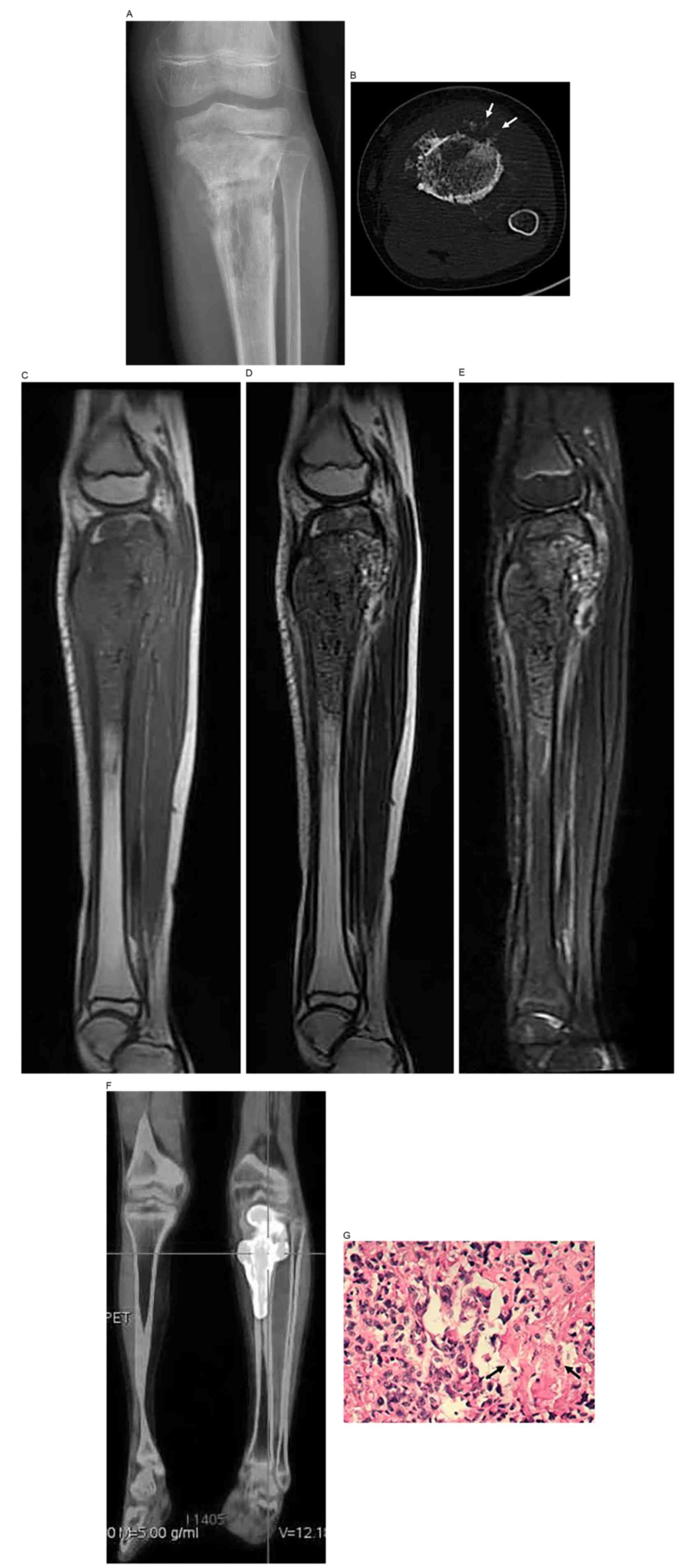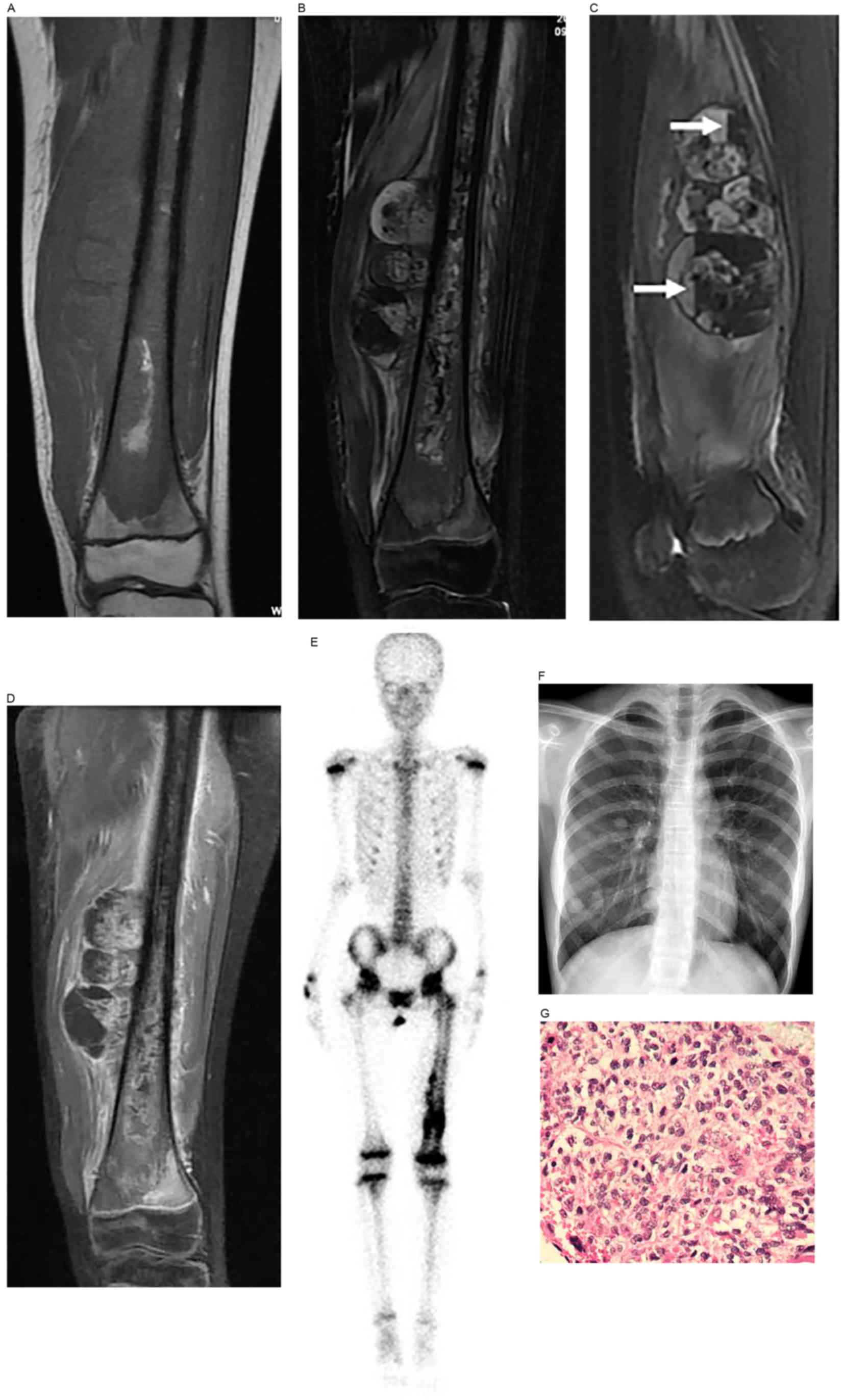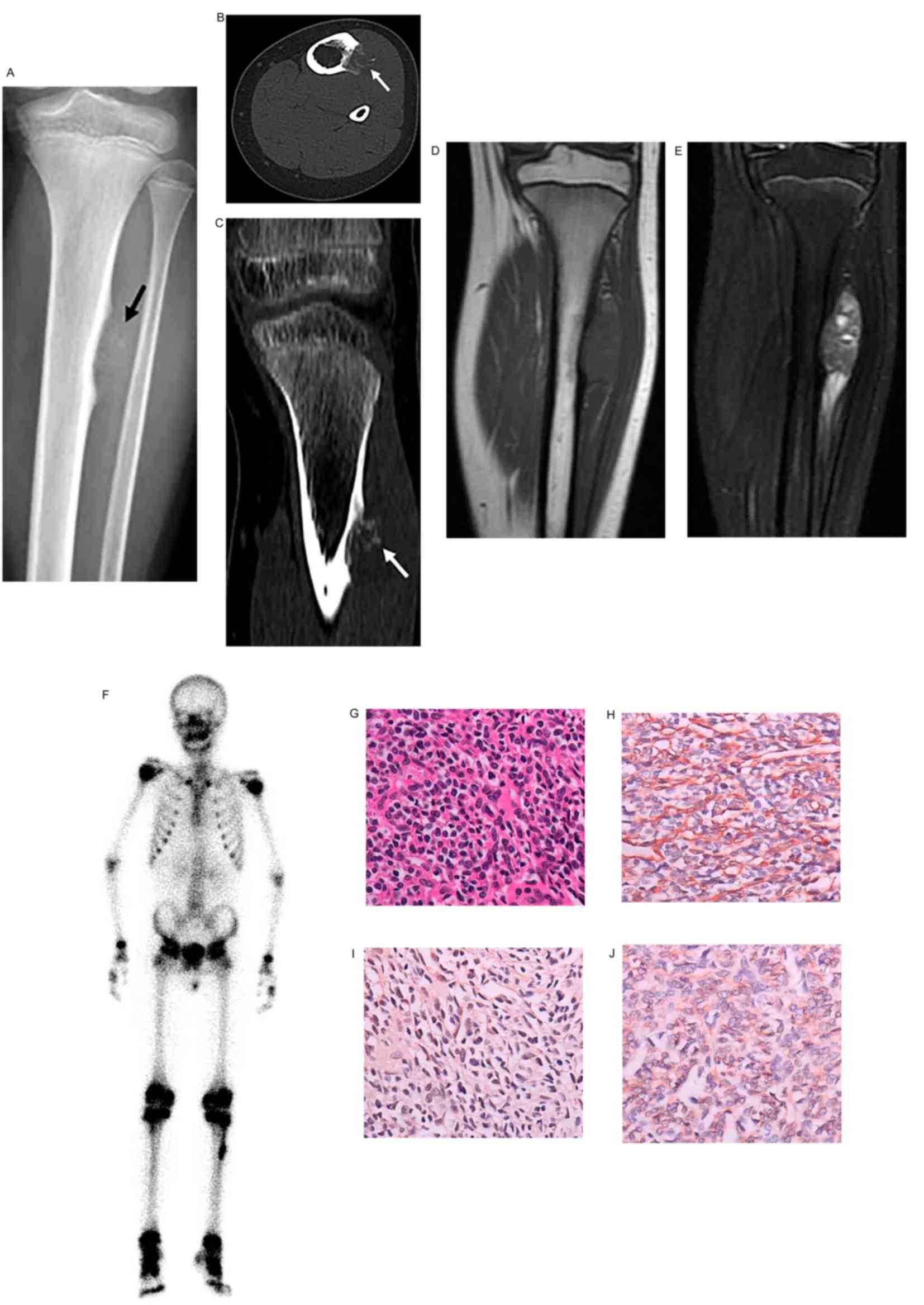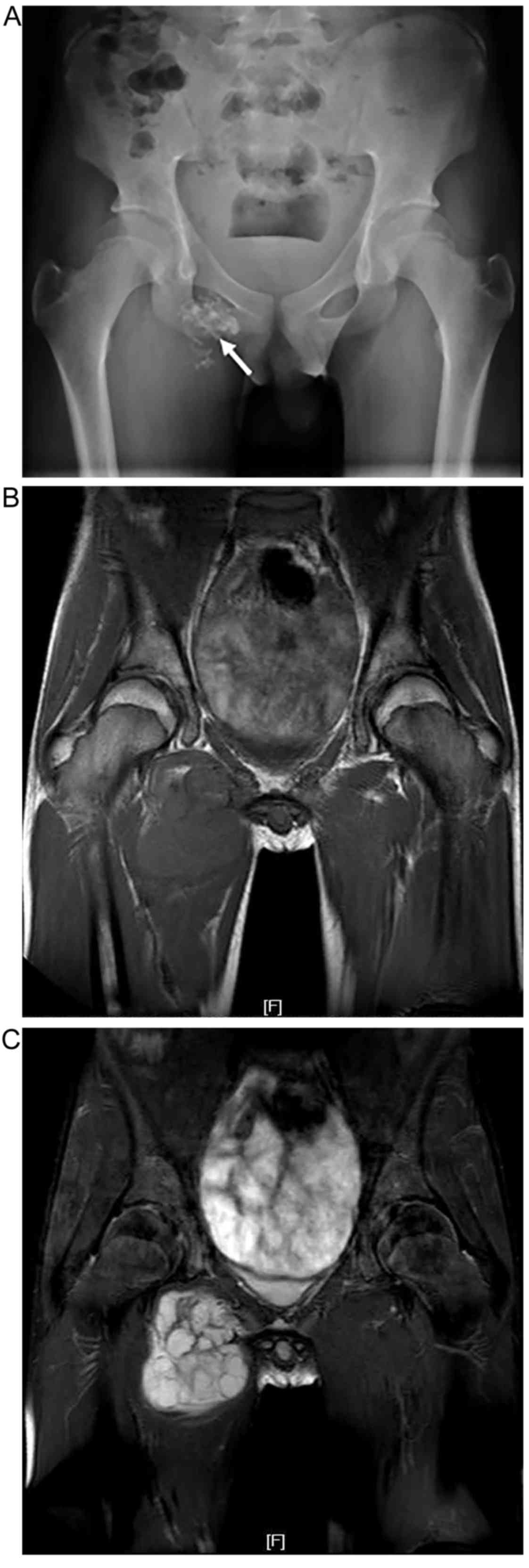|
1
|
Wootton-Gorges SL: MR Imaging of primary
bone tumors and tumor-like conditions in children. Magn Reson
Imaging Clin N Am. 17:469–487. 2009. View Article : Google Scholar : PubMed/NCBI
|
|
2
|
Brisse H, Ollivier L, Edeline V,
Pacquement H, Michon J, Glorion C and Neuenschwander S: Imaging of
malignant tumours of the long bones in children: Monitoring
response to neoadjuvant chemotherapy and preoperative assessment.
Pediatr Radiol. 34:595–605. 2004. View Article : Google Scholar : PubMed/NCBI
|
|
3
|
Collins M, Wilhelm M, Conyers R, Herschtal
A, Whelan J, Bielack S, Kager L, Kühne T, Sydes M, Gelderblom H, et
al: Benefits and adverse events in younger versus older patients
receiving neoadjuvant chemotherapy for osteosarcoma: Findings from
a meta-analysis. J Clin Oncol. 31:2303–2312. 2013. View Article : Google Scholar : PubMed/NCBI
|
|
4
|
Wright EH, Gwilym S, Gibbons CL, Critchley
P and Giele HP: Functional and oncological outcomes after
limb-salvage surgery for primary sarcomas of the upper limb. J
Plast Reconstr Aesthet Surg. 61:382–387. 2008. View Article : Google Scholar : PubMed/NCBI
|
|
5
|
Eftekhari F: Imaging assessment of
osteosarcoma in childhood and adolescence: Diagnosis, staging and
evaluating response to chemotherapy. Cancer Treat Res. 152:33–62.
2009. View Article : Google Scholar : PubMed/NCBI
|
|
6
|
Kaste SC: Imaging pediatric bone sarcomas.
Radiol Clin North Am. 49:749–765. 2011. View Article : Google Scholar : PubMed/NCBI
|
|
7
|
Costelloe CM and Madewell JE: Radiography
in the initial diagnosis of primary bone tumors. AJR Am J
Roentgenol. 200:3–7. 2013. View Article : Google Scholar : PubMed/NCBI
|
|
8
|
Rana KA, Meyer J, Ibrahim S, Ralls M and
Kent PM: The role of imaging of malignant bone tumors in children
and young adults. Curr Probl Cancer. 37:181–191. 2013. View Article : Google Scholar : PubMed/NCBI
|
|
9
|
Fletcher CDM, Bridge JA, Hogendoorn PCW
and Mertens F: World Health Organization classification of tumours
of soft tissue and bone [M]. Lyon: IARC Press; pp. 264–81. 2013
|
|
10
|
Lee RK, Chu WC, Leung JH, Cheng FW and Li
CK: Pathological fracture as the presenting feature in pediatric
osteosarcoma. Pediatr Blood Cancer. 60:1118–1121. 2013. View Article : Google Scholar : PubMed/NCBI
|
|
11
|
Murphey MD, Senchak LT, Mambalam PK, Logie
CI, Klassen-Fischer MK and Kransdorf MJ: From the radiologic
pathology archives: Ewing sarcoma family of tumors:
Radiologic-pathologic correlation. Radiographics. 33:803–831. 2013.
View Article : Google Scholar : PubMed/NCBI
|
|
12
|
Fayad LM, Jacobs MA, Wang X, Carrino JA
and Bluemke DA: Musculoskeletal tumors: How to use anatomic,
functional and metabolic MR techniques. Radiology. 265:340–356.
2012. View Article : Google Scholar : PubMed/NCBI
|
|
13
|
Benassi MS, Rimondi E, Balladelli A,
Ghinelli C, Magagnoli G and Vanel D: The role of imaging for
translational research in bone tumors. Eur J Radiol. 82:2115–2123.
2013. View Article : Google Scholar : PubMed/NCBI
|
|
14
|
Hwang S and Panicek DM: The evolution of
musculoskeletal tumor imaging. Radiol Clin North Am. 47:435–453.
2009. View Article : Google Scholar : PubMed/NCBI
|
|
15
|
Meyers PA, Gorlick R, Heller G, Casper E,
Lane J, Huvos AG and Healey JH: Intensification of preoperative
chemotherapy for osteogenic sarcoma: Results of the Memorial
Sloan-Kettering (T12) protocol. J Clin Oncol. 16:2452–2458. 1998.
View Article : Google Scholar : PubMed/NCBI
|
|
16
|
Zhang J, Cheng K, Ding Y, Liang W, Ding Y,
Vanel D and Cheng X: Study of single voxel 1H MR spectroscopy of
bone tumors: Differentiation of benign from malignant tumors. Eur J
Radiol. 82:2124–2128. 2013. View Article : Google Scholar : PubMed/NCBI
|
|
17
|
Dallaudiere B, Hummel V, Hess A, Lincot J,
Preux PM, Maubon A and Monteil J: Tumoral hypoxia in osteosarcoma
in rats: Preliminary study of blood oxygenation level-dependent
functional MRI and 18F-misonidazole PET/CT with diffusion-weighted
MRI correlation. AJR Am J Roentgenol. 200:187–192. 2013. View Article : Google Scholar
|
|
18
|
Padhani AR, Krohn KA, Lewis JS and Alber
M: Imaging oxygenation of human tumours. Eur Radiol. 17:861–872.
2007. View Article : Google Scholar : PubMed/NCBI
|
|
19
|
Yarmish G, Klein MJ, Landa J, Lefkowitz RA
and Hwang S: Imaging characteristics of primary osteosarcoma:
Nonconventional subtypes. Radiographics. 30:1653–1672. 2010.
View Article : Google Scholar : PubMed/NCBI
|
|
20
|
Murphey MD, wan Jaovisidha S, Temple HT,
Gannon FH, Jelinek JS and Malawer MM: Telangiectatic osteosarcoma:
Radiologic-pathologic comparison. Radiology. 229:545–553. 2003.
View Article : Google Scholar : PubMed/NCBI
|
|
21
|
Balamuth NJ and Womer RB: Ewing's sarcoma.
Lancet Oncol. 11:184–192. 2010. View Article : Google Scholar : PubMed/NCBI
|
|
22
|
Mosier SM, Patel T, Strenge K and Mosier
AD: Chondrosarcoma in childhood: The radiologic and clinical
conundrum. J Radiol Case Rep. 6:32–42. 2012.PubMed/NCBI
|
|
23
|
Küpeli S, Varan A, Gedikoğlu G and
Büyükpamukçu M: Sacral mesenchymal chondrosarcoma in childhood: A
case report and review of the literature. Pediatr Hematol Oncol.
27:564–573. 2010. View Article : Google Scholar : PubMed/NCBI
|
|
24
|
Qasem SA and DeYoung BR: Cartilage-forming
tumors. Semin Diagn Pathol. 31:10–20. 2014. View Article : Google Scholar : PubMed/NCBI
|
|
25
|
Carroll G, Breidahl W and Robbins P:
Musculoskeletal lymphoma: MRI of bone or soft tissue presentations.
J Med Imaging Radiat Oncol. 57:663–673. 2013. View Article : Google Scholar : PubMed/NCBI
|
|
26
|
Demircay E, Hornicek FJ Jr, Mankin HJ and
Degroot H III: Malignant lymphoma of bone: A review of 119
patients. Clin Orthop Relat Res. 471:2684–2690. 2013. View Article : Google Scholar : PubMed/NCBI
|
|
27
|
Hu KJ, Sun ZZ, Rui YJ, Mi JY and Ren MX:
Shortage of paediatricians in China. Lancet. 383:9542014.
View Article : Google Scholar : PubMed/NCBI
|




















